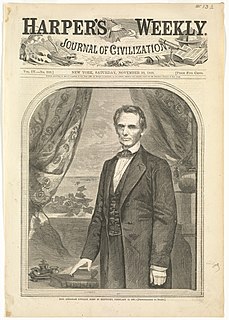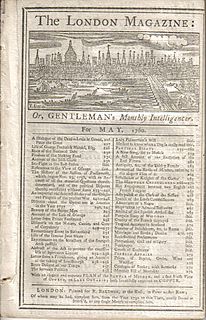Related Research Articles
Webster's Dictionary is any of the English language dictionaries edited in the early 19th century by American lexicographer Noah Webster (1758-1843), as well as numerous related or unrelated dictionaries that have adopted the Webster's name in honor. "Webster's" has since become a genericized trademark in the United States for English dictionaries, and is widely used in dictionary titles.

Ferdinand Brunetière was a French writer and critic.
Argosy, later titled The Argosy, Argosy All-Story Weekly and The New Golden Argosy, was an American pulp magazine from 1882 through 1978, published by Frank Munsey until its sale to Popular Publications in 1942. It is the first American pulp magazine. The magazine began as a children's weekly story–paper entitled The Golden Argosy. In the era before the Second World War, Argosy was regarded as one of the "Big Four" pulp magazines, - the most prestigious publications in the pulp market, that many pulp magazine writers aspired to publish in. John Clute, discussing the American pulp magazines in the first two decades of the twentieth century, has described The Argosy and its companion The All-Story as "the most important pulps of their era."

Harper's Weekly, A Journal of Civilization was an American political magazine based in New York City. Published by Harper & Brothers from 1857 until 1916, it featured foreign and domestic news, fiction, essays on many subjects, and humor, alongside illustrations. It carried extensive coverage of the American Civil War, including many illustrations of events from the war. During its most influential period, it was the forum of the political cartoonist Thomas Nast.
The New International Encyclopedia was an American encyclopedia first published in 1902 by Dodd, Mead and Company. It descended from the International Cyclopaedia (1884) and was updated in 1906, 1914 and 1926.

The London Magazine is a publication of arts, literature and miscellaneous interests. Its history ranges across nearly three centuries and several reincarnations, publishing writers including William Wordsworth, William S. Burroughs, Winston Churchill and John Keats.

Overland Monthly was a monthly magazine based in California, United States, and published in the 19th and 20th centuries.

Sidney Perley (1858–1928) was a lawyer, writer, poet, author, editor, and historian.

The Magazine of Art was an illustrated monthly British journal devoted to the visual arts, published from May 1878 to July 1904 in London and New York City by Cassell, Petter, Galpin & Co. It included reviews of exhibitions, articles about artists and all branches of the visual arts, as well as some poetry, and was lavishly illustrated by leading wood-engravers of the period such as William Biscombe Gardner.

This article contains a timeline of the history of Cleveland, Ohio, United States.

Mary Hartwell Catherwood was an American writer of popular historical romances, short stories, and poetry. Early in her career she published under her birth name, Mary Hartwell, and under the pseudonym Lewtrah. She was known for setting her works in the Midwest, for a strong interest in American dialects, and for bringing a high standard of historical accuracy to the period detail of her novels.

David Van Nostrand was a New York City publisher.

Gustave Chouquet was a French music historian, music critic, and teacher of French.

Arthur's Home Magazine (1852-ca.1898) or Ladies' Home Magazine was an American periodical published in Philadelphia by Timothy Shay Arthur. Editors Arthur and Virginia Francis Townsend selected writing and illustrations intended to appeal to female readers. Among the contributors were Mary Tyler Peabody Mann and Kate Sutherland. In its early years the monthly contained a selection of articles originally published in Arthur's weekly Home Gazette. Its nonfiction stories contained occasional factual inaccuracies for the sake of a good read. A contemporary review judged it "gotten up in good taste and well; and is in nothing overdone. Even its fashion plates are not quite such extravagant caricatures of rag-baby work as are usually met with in some of the more fancy magazines." Readers included patrons of the Mercantile Library Association of San Francisco.

Engineering Magazine was an American illustrated monthly magazine devoted to industrial progress, first published in 1891. The periodical is published under this title until October 1916. Sequentially from Nov. 1916 to 1927 it was published as Industrial Management.
Joseph Timothy Haydn, compiler of dictionaries, was well known as the author of the "Dictionary of Dates", 1841, and of the "Book of Dignities", 1851. The "Book of Dignities" was a modernised form of Robert Beatson's "Political Index", but omits the lists of holders of many important offices. He also edited Samuel Lewis' "Topographical Dictionaries". His name is used in the "Haydn Series" of dictionaries, which are on the same lines as those compiled by him. He does not, however, appear to have taken any part in their actual compilation. They are the "Universal Index of Biography", edited by J. B. Payne, 1870; "Bible Dictionary", edited by C. Boutell, 1871 ; "Dictionary of Popular Medicine and Hygiene", edited by Dr. E. Lankester, 1874. For a short time before his death, on 18 January 1856, Haydn had been in receipt of a small pension of £25 granted by the government. It was continued to his widow.

Gloucestershire Notes and Queries was an illustrated quarterly magazine of the history and antiquities of Gloucestershire published from 1879 under the editorship of the Reverend Beaver Henry Blacker (1821-90). The first volume was published in 1881. After the death of Blacker, the editor was the solicitor, genealogist, and publisher, William Phillimore Watts Phillimore, founder of the eponymous publishing firm.
Charles Howard Shinn was a horticulturalist, author, inspector of California Experiment Stations, and forest ranger in California.

Kalākaua was the last king and penultimate monarch of the Kingdom of Hawaiʻi. The inherited position of the kingdom's monarch became a legislatively elected office with Lunalilo. Upon Lunalilo's death, Kalākaua won election over his political opponent Queen Emma. He reigned from February 12, 1874, until his death in San Francisco, California, on January 20, 1891.

American Agriculturist was an agricultural publication for farm, home, and garden in the United States, published in English and German editions. Its subtitle varied over time: for the Farm, Garden, and Household (1869), for the Household, Garden, Farm (1877). It often included the tag-line Full of Good Things for Everybody, in City, Villge, and Country (1877), etc. Solon Robinson was one of its writers. It was illustrated by numerous engravings. In 1885, it published a Family Cyclopaedia. In 1889, it published The Illustrated Dictionary of Gardening: A Practical and Scientific Encyclopedia of Horticulture for Gardeners and Botanists,, which was edited by George Nicholson, This became the basis of the RHS's Dictionary of Gardening.
References
- ↑ "Literature". Encyclopedia of Cleveland History. Case Western Reserve University. 11 May 2018.
- ↑ Walter Scott Robison (1887). History of the City of Cleveland. Jazzybee Verlag. pp. 144–145. ISBN 9783849675714.
- ↑ "Periodical or newspaper: Magazine of western history". Library of Congress.
- ↑ "The National magazine". HathiTrust. Ann Arbor, Michigan. 1891.